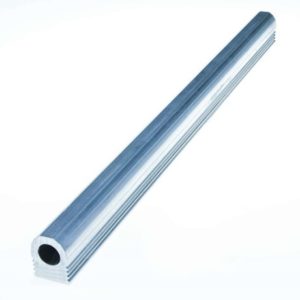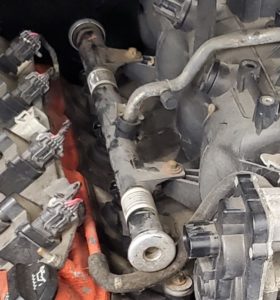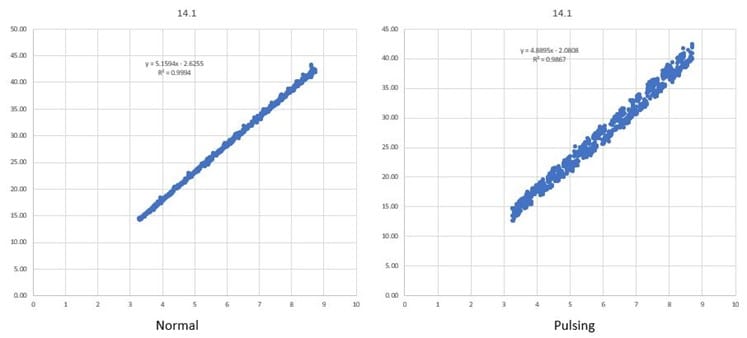Author: Greg Banish – Calibrated Success, Inc.

Small Factory Fuel Rails are fairly common

Some vehicles like the Fox Body Mustang and this SN95 Mustang are built with relatively small fuel rails. From an OEM standpoint, this is nice because it saves weight and minimizes the amount of fuel subject to heating under the hood before being injected to the ports. One problem with pencil-sized rails is that when larger flow rate injectors are fitted to the engine, a more significant percentage of their volume is delivered near maximum pulse width. With enough fuel pump, we mostly overcome this, but we know that there are periodically high and low pressure spots within the fuel rails as the engine walks through the firing order. The OEM solution has been to include a small pulsation damper on their feed lines to even out the pressure load on the pump itself, but this still potentially leaves individual injectors firing at a point when local rail pressure may be lower than the average. This is bad news for air-fuel ratio control with large injectors, especially at high loads. Fuel pressure regulators also impart some damping to the system, especially when they are close the source of the noise (fuel rail).
Fuel Pulsation Dampers are often used by OEMs to address the problem

As manufacturers switched from return fuel to deadheaded systems, pressure regulators were sometimes replaced by pulsation dampers right on the rail in the same location as seen on this LS1 engine.
Tuned mass dampers are nothing new in the engineering world. Many skyscrapers like Taipei 101 use heavy suspended weights near the top to intentionally move in opposition to the building’s natural frequency. Changing the math to fluids works, and a damper can indeed be tuned to cancel vibration in cavity like a fuel rail at some frequency. The problem becomes addressing a broad range of frequencies as the engine runs through the RPM range exciting the rail at variable intervals. A single diaphragm and spring rate will not be ideal everywhere, but they can knock down some peaks.
Larger Capacity Fuel Rails go a long way on their own…

Traditionally, the solution has been to upgrade the fuel rails themselves. 5/8” billet rails quickly became the norm at performance shops and garages across the country. The larger bore rails addressed the issue of pressure variation with two improvements. First, the rails each being fed from their own -8AN line meant that pump pressure and flow were now equally provided to both rails, eliminating the longer path to half the engine if the second rail was fed in series by a connector line. Second, the increased volume provided what we in the engineering world like to call “Mass Damping” where any single gulp of fuel from an injector now only took a smaller percentage of the available fuel in the rail.
The OEMs know the ‘oversized fuel rail’ trick as well

If we made the rails infinite volume, mass damping would also be infinite, and each injector would have perfectly consistent pressure before and during each pulse. Alas, there is a practical limit, so a compromise in rail volume is usually driven by packaging space. Generally speaking, larger volume is better to reduce pulsations. More recent OEM vehicles oddly have gone this direction now as engine (injector) noise drove them to reduce pulsations in the name of quality. A nice side benefit is better distribution at high loads, IF the pump can feed it through the existing lines. One potential down side is longer priming time required to reach the desired rail pressure at start, but since we are often using more powerful fuel pumps, this is often not an issue. Heat soak and vapor lock also become concerns in hot environments as more fuel volume is heated under the hood.
Setting up a proper test to determine the impact of fuel pressure pulsations

Through the course of testing fuel injectors on our prototype Fuel Injector Test Bench designs at Calibrated Success, we ran into all sorts of issues that required engineering solutions. In general, one of the primary goals of the bench was to make sure that we are only testing the fuel injectors, not the bench itself. I wanted to make sure that all of the output data changes were a result of the injectors being tested instead of some limitation in capacity, flow, pressure, or timing. By feeding the injectors with a rather large pump and regulator, we made sure that flow capacity was higher than anything we’d need running up to four high impedance injectors at a time. -8AN lines were chosen for all critical flow paths and the rail itself features a 1” ID bore. The 1” bore has over 2.5 times the volume of fluid per unit length as the popular 5/8” billet rails that the industry has adopted as generally sufficient. Together, these constitute a significant volume of pressurized fluid that can equally supply the injectors at any point along the rail.
And the data is in!
As we were testing, I had a few data sets give me some really noisy results. What used to be very clean linear plots from my known sample injectors suddenly had become a cloud of data. The “cloud” actually looked like two separate lines of data with more points floating between them.

Sequential Fueling can reduce fuel rail pressure fluctuations as well

Eventually, we found the culprit. During one of the software updates, we lost the sequential firing order of the injectors and were now seeing them operate in batch fire (simultaneous) mode. All four injectors were hitting the rail at exactly the same time, which was enough to change how the injectors flow. Interestingly, the rail pressure sensor only showed ~4kPa peak to peak variation because that sensor too is time-averaged in the controller. It was the pulsations inside the rail causing the flow deviations. What’s worse is that it wasn’t necessarily a single standing wave, as we would have seen that resonate more at a particular pulse width. No single tuned frequency (spring and mass) damper would have resolved this. We just had “noise”. Switching the ECU back to a proper firing order instantly resolved the condition as we “spread out” the consumption across more time and space.
Lessons Learned
- Injector performance is affected by local rail pressure. Large pulsations can randomly adjust your fuel delivery on each shot.
- Proper fuel system (feed lines, rails, regulator) sizing goes a long way toward getting consistent injector performance. Larger rail volumes offer more mass damping.
- Running in batch fire mode greatly increases the pressure excitation of the rail. Run a sequential firing order if possible.
- Fuel Rail Pulsation Dampers can help, but are usually best to address a specific frequency. They should be added as a last resort.
- A fuel pressure regulator installed at the rail doubles as a damper, but sometimes adding another pulsation damper helps.
- Don’t expect a pulsation damper to fix a fundamental system issue.

Wanna Learn More about EFI?
Check out ‘The EFI Tuners Guide’ here at DIYAutoTune.com. This article series aims to be a practical and detailed approach to learning about Electronic Fuel Injection, walking you through your EFI Project and helping you to understand how to get the most out of your car!
